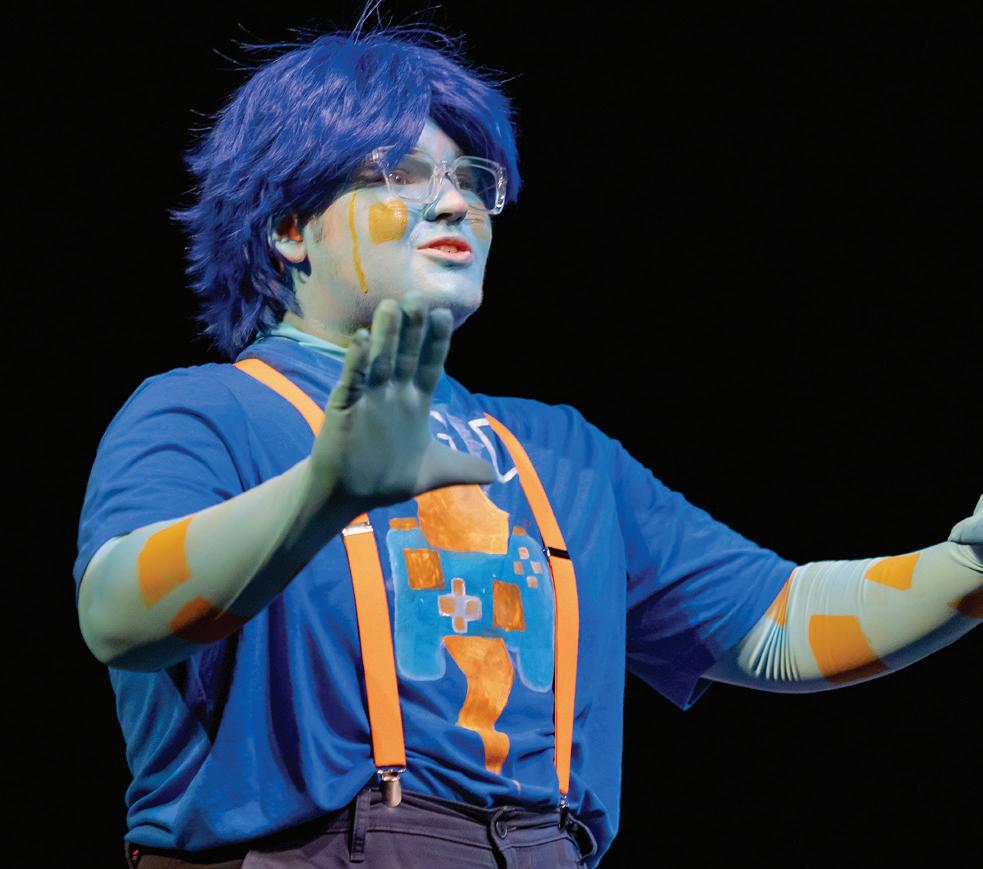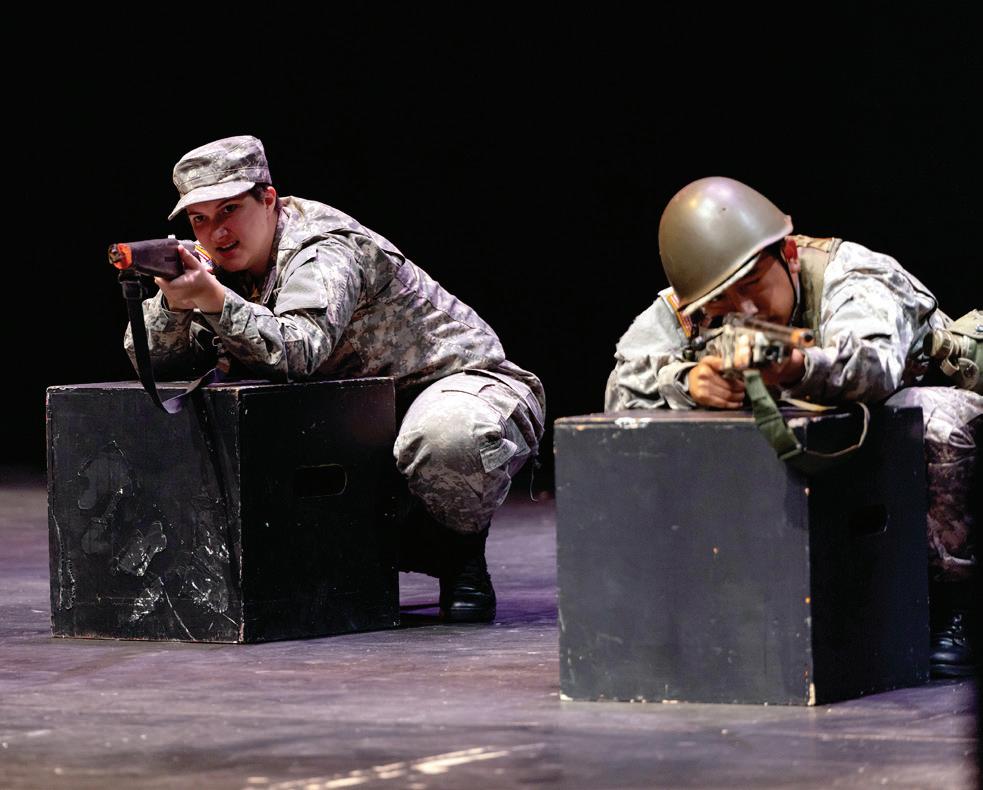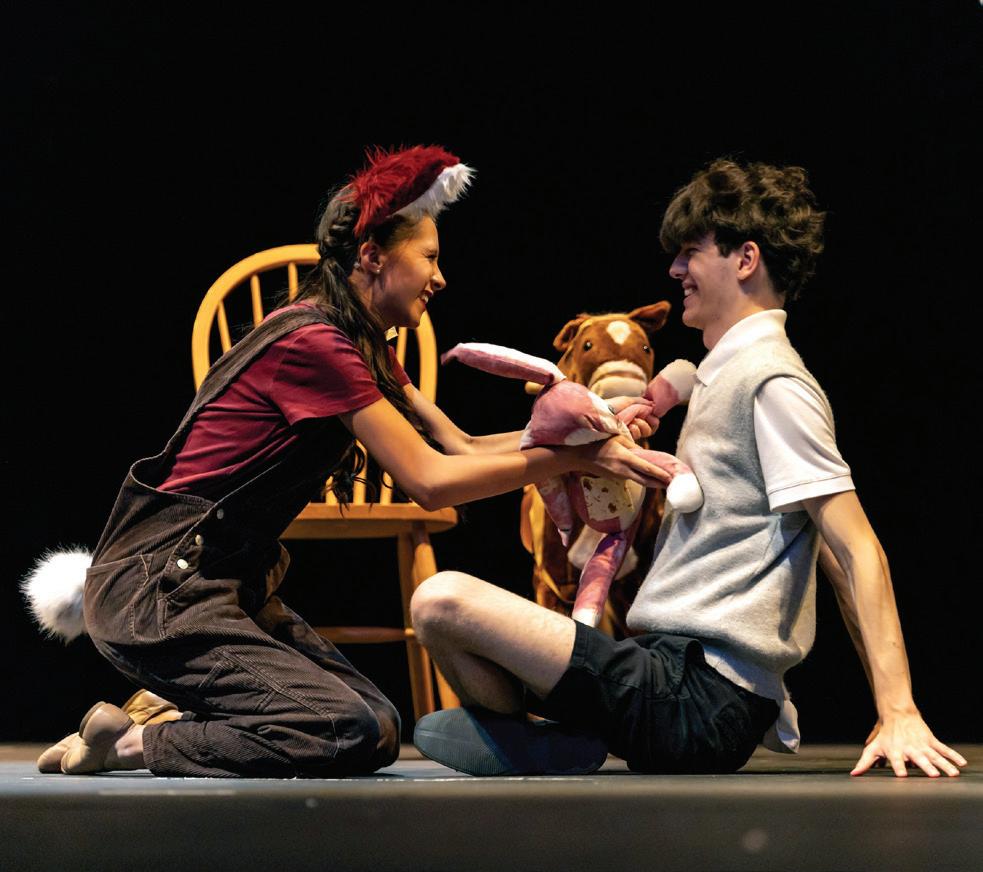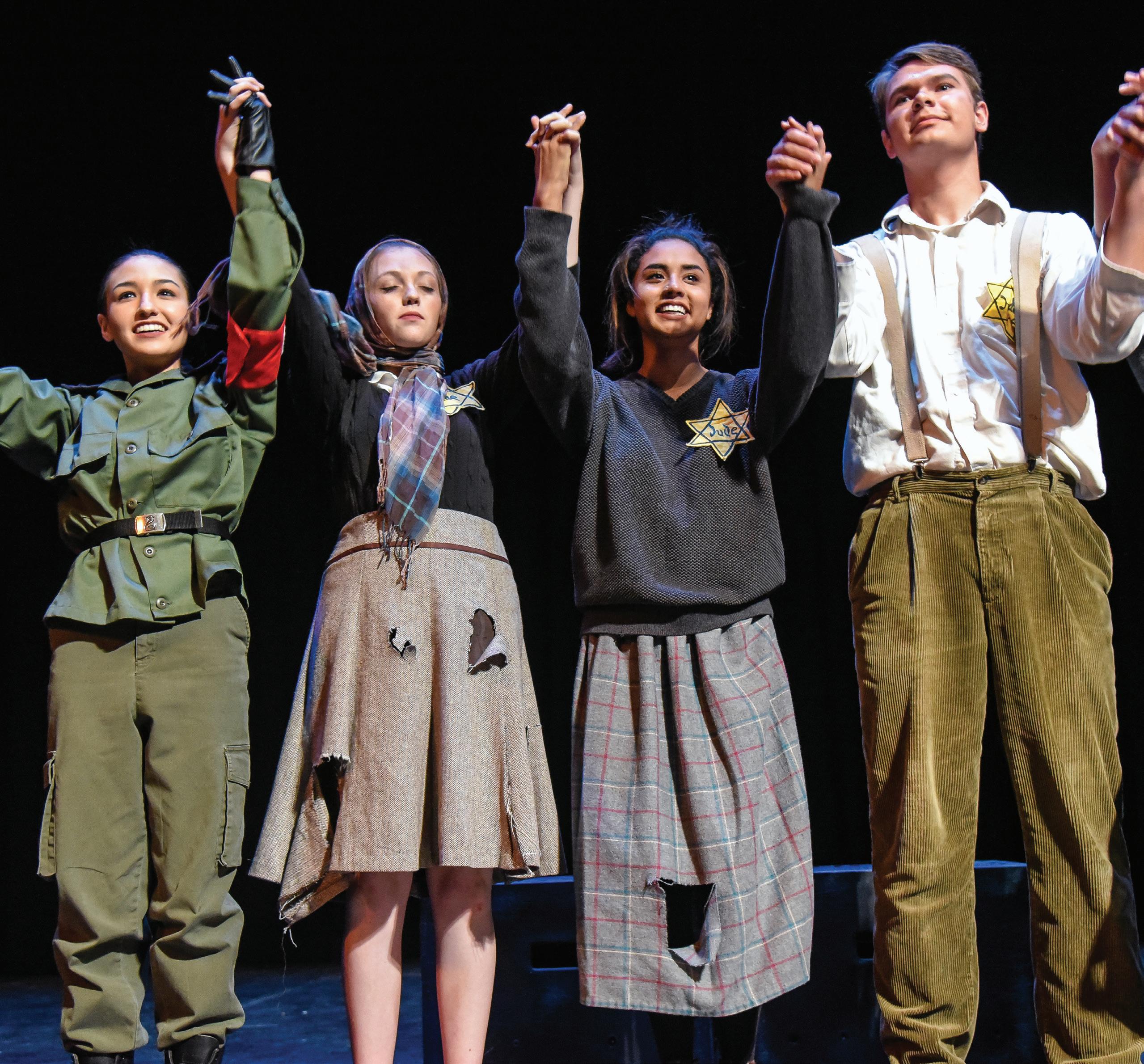2024-25 Chapter Select One-Act Production Guide




ITF’s Chapter Select One-Act Showcase features simply staged one-acts that celebrate storytelling and highlight outstanding student performances from EdTA chapters around the country and world. The showcase includes a robust lineup of short performances including one-acts, cuttings from fulllength productions, reader’s theatre, dance, mime, comedy, drama, etc. For the purposes of this guide, all eligible short performances will be referred to as “one-acts.”
To be considered for the Chapter Select OneAct Showcase, one-acts must be adjudicated at International Thespian Society (ITS) chapter events (festivals/conferences). Chapters then recommend one outstanding short performance from their
festival/conference to present their work at the International Thespian Festival (ITF). A limited number of performance slots are available at ITF; please check with your chapter after October 15 to learn if your chapter has a spot in the showcase for the coming year.
Chapters are encouraged, though not required, to adjudicate one-acts using the Chapter Select OneAct Rubric. Please check with your chapter director to learn more about the adjudication process and how your troupe may qualify.
If your troupe is not part of an active chapter, visit itf. schooltheatre.org to learn about other performance opportunities.
Using the Chapter Select intention form, chapters must inform EdTA of their plans to submit a recommended one-act to the Chapter Select OneAct Showcase at ITF by October 2.
After October 2, ITF staff will compare the reservations submitted against the available performance slots. If more chapters request slots than are available, EdTA will assign the performance slots to chapters using the following process:
• Any chapter that did not present a performance in the Chapter Select One-Act Showcase the previous year will receive top priority.
• The remaining slots (if any) will be selected by lottery among the remaining troupes. A thirdparty list randomizer will be utilized to ensure total objectivity.
• Any chapter that does not receive a performance slot will be placed on a waiting list (in the order selected by the list randomizer) to be invited if any troupes decline their invitation or drop out of the showcase.
Chapter leaders will be notified of their status by October 15.


• Chapters are responsible for training and recruiting adjudicators to evaluate short performances at their festivals/conferences. Chapters are encouraged to use the rubrics included in this guide for adjudication.
• Using the Chapter Select One-Act Showcase recommendation form, chapters may nominate one performance and one alternate performance from their chapter event for the Chapter Select One-Act Showcase at ITF. Note that the recommended Thespian troupe must be in good standing with EdTA to be eligible to present their material at ITF.
• EdTA encourages chapters to nominate productions promoting diversity, equity, and inclusion in the cast, crew, director, playwright, and/or the subject matter of the work.
Any Thespian troupe in good standing with ITS and EdTA is eligible to present their material in the Chapter Select One-Act Showcase at ITF. One-acts must be adjudicated at an event in their home chapter and be recommended to ITF by their chapter officials.
Troupes invited to perform at ITF must adhere to the production requirements and specifications outlined in this guide.
Troupes must be available to present their oneacts on any scheduled day of ITF. Due to the large number of variables surrounding festival scheduling, requests for certain days and/or venues cannot be honored. The ITF staff and production team determine the schedule and assign venues for each production in coordination with the host venue. Troupes will be notified of their performance date in advance so they may secure licensing agreements for the scheduled performance. Directors must provide proof of licensing agreements and insurance certifications for the planned performance.
To give as many troupes as possible the chance to perform at ITF, troupes may not perform on the ITF Main Stage and in the Chapter Select One-Act Showcase in the same year.


Troupes presenting material in the Chapter Select One-Act Showcase will be allotted one (1) hour for load-in, performance, and strike. It is recommended that troupes allocate 10 minutes to load-in, 45 minutes to the performance, and 5 minutes to strike. Productions with run times that exceed one (1) hour are ineligible to present their material at ITF.
Visit the Chapter Select One-Act Showcase webpage for participation deadlines.

Chapters are responsible for recruiting and training adjudicators to score performances at their own chapter events. To ensure a consistent experience for participating troupes, EdTA encourages chapters to use the rubrics included in this guide to evaluate performances. Check with your chapter director for specific details about the adjudication process in your chapter.
The full rubric, an overall score, and written feedback from the adjudicators should be shared with the participating troupe’s director once the adjudication is complete.
Adjudicators should disclose any conflicts of interest prior to evaluating a production and should not be assigned to evaluate a production should any of the following conflicts of interest arise:
• The adjudicator is employed at the presenting school.
• The adjudicator and/or their troupe is also submitting a production for consideration.
• Any other conflicts of interest the adjudicator discloses.
Education is central to the adjudication process. The evaluation rubrics included in this guide are designed to provide educational feedback to directors and students involved with the production, regardless of whether the show is recommended by the chapter to present their material in the Chapter Select One-Act Showcase at ITF.
Use for one-acts or cuttings from full-length productions
School:
Production Title:
Interpretation The director’s concept and actors’ interpretations clarify the play’s meaning, enhancing the story and action.
The overall production demonstrates a unifying vision with aesthetic choices that enhance the theme, mood, time, and place.
Musical expression (if any) clarifies and enhances the story and action of the play.
Comment:
Tempo/Rhythm
The actors always picked up lines/cues.
Tempo and rhythm enhance the mood of the play and the playwright’s intent.
Non-speaking moments communicate subtext and enhance and clarify the story and action of the play.t.
Comment:
Blocking/ Composition
The blocking was innovative, natural, and justified by the actors.
Blocking, stage pictures, and use of space work together to communicate relationships and clarify and enhance the story and action of the play.
The director’s concept and actors’ interpretations support the story and action of the play.
Aesthetic choices communicate theme, mood, time, and place.
Musical expression (if any) communicates the story and action of the play.
For internal use only
The director’s concept and actors’ interpretations somewhat support the story and action of the play.
Some, but not all aesthetic choices communicate theme, mood, time, and place.
Musical expression (if any) mostly communicates the story and
Troupe:
The director’s concept is unclear and/or the actors’ interpretations detract from the story and action of the play.
There is little or no communication of a clear theme, mood, time, and/ or place.
Musical expression (if any) does not support the story and/or action of the play.
The actors usually picked up lines/cues.
Tempo and rhythm support the mood of the play and the playwright’s intent.
Non-speaking moments communicate subtext to support the story and action of the play.
The actors inconsistently picked up lines/cues.
Tempo and rhythm mostly support the mood of the play and the playwright’s intent.
Non-speaking moments mostly communicate subtext to support the story and action of the play.
The actors rarely pick up lines/cues.
Tempo and rhythm rarely support the mood of the play and the playwright’s intent.
Non-speaking moments rarely communicate subtext to support the story and action of the play.
The blocking was interesting, natural, and justified by the actors.
Blocking, stage pictures, and use of space work together to communicate relationships and support the story and action of the play
The blocking was somewhat interesting, natural, and justified by the actors.
Blocking, stage pictures, and use of space mostly work to communicate relationships and support the story and action of the play.
The blocking was rarely interesting, natural, and/or justified by the actors.
Blocking, stage pictures, and use of space rarely work together to support the story and the action of the play or communicate relationships.
Comment:
Characterization
Lead and supporting actors are consistently emotionally and physically believable; committed choices and tactics towards an objective prompt intuitive reactions to partners.
Cast concentration and commitment to moment-tomoment choices appear natural and intuitive and are sustained throughout the performance.
Cast integrates voice, body, and emotion to create a richly detailed set of character relationships that tells a story.
Ensemble was seamlessly integrates to the fullest potential, supporting and enhancing the action of the play.
Comment:
Overall Effect of the Performance All aspects – technical and performance – worked together to present an innovative, cohesive production.
Comment:
Additional Adjudicator Comments:
Lead and supporting actors are emotionally and physically believable; committed choices and tactics toward an objective prompt identifiable reactions to partners.
Cast concentration and commitment to momentto-moment choices are sustained throughout the performance.
Cast integrates voice, body, and emotion to create a believable set of character relationships that tell a story.
Ensemble work supports the action of the play.
Lead and supporting actors are mostly emotionally and physically believable; choices and tactics toward an objective prompt some reactions to partners.
Cast concentration and commitment to moment-tomoment choices are mostly sustained.
Cast mostly integrates voice, body, and emotion to create believable character relationships that tell a story.
Ensemble work mostly supports the action of the play.
Lead and supporting actors are rarely emotionally and physically believable; choices, tactics, objectives, and a relationship to partners is not evident.
Cast concentration and commitment to moment-tomoment choices are limited or absent.
Cast members’ voice, body, and emotional choices rarely create a sustained set of believable character relationships that tell a story.
Ensemble work rarely supports the action of the play.
All aspects – technical and performance – worked together to present a cohesive production.
Several aspects – technical and performance – worked together to present a generally cohesive production.
Few aspects – technical and performance – worked together to present a production.
Use for performances other than one-acts, reader’s theatre, or cuttings from full-length productions.
School:
Production Title:
Interpretation
Comment:
Tempo/Rhythm
Tempo and rhythm enhance the mood, theme, and/or action of the piece.
Non-speaking moments communicate subtext and enhance and clarify the narrative.
Comment:
Blocking/ Composition
Movement choices are innovative and surprising, yet fully justified.
Use of space, movement, and/or stillness work together to clarify and enhance the narrative and/or the mood of the performance.
Performance
Performance
For internal use only
Troupe:
Tempo and rhythm support the mood, theme, and/or action of the piece.
Non-speaking moments consistently communicate subtext.
Tempo and rhythm occasionally align with the mood, theme, and/or action of the piece.
Non-speaking moments mostly communicate subtext.
Few performance choices work together; the piece lacks cohesion.
Movement choices seem natural for the piece.
Use of space, movement, and/or stillness support the mood of the performance.
Movement choices appear mostly natural and aligned with the piece.
Use of space, movement, and/or stillness seem mostly aligned with the mood of the performance.
Tempo and rhythm rarely support the mood, theme, and/or action of the piece.
Non-speaking moments rarely communicate subtext.
Movement choices seem random and/or unjustified.
Use of space, movement, and/or stillness detract from the mood of the performance. Comment:
and commitment to momentto-moment choices appear natural and intuitive and are sustained throughout the performance.
Choices and expression create a richly detailed performance and deepen meaning.
Concentration and commitment to momentto-moment choices are sustained throughout the performance.
Choices and expression support the performance and create meaning.
Concentration and commitment to moment-tomoment choices are mostly sustained throughout the performance.
Choices and expression mostly support the performance.
Concentration and commitment to moment-tomoment choices are lacking.
Choices and expression detract from the performance.
Comment:
Overall Effect of the Performance
All aspects – technical and performance – worked together to present an innovative, cohesive production.
All aspects – technical and performance – worked together to present a cohesive production.
Several aspects – technical and performance – worked together to present a generally cohesive production.
Few aspects – technical and performance – worked together to present a production.
The script has both a strong entertainment and/or educational value. � Yes � No
The script is within the emotional capabilities and skill set of the cast and highlights their strengths. � Yes � No
Additional Adjudicator Comments:
Judge’s Name (Please Print)
Judge’s Signature
School:
Production Title:
Voice
Actors speak in an easy, natural manner.
Volume is varied, appropriate and supportive of the text and situation.
Comment:
Vocal Expression
Actors employ vocal expression to illuminate the text and subtext.
Vocal expression clarifies or enhances the situation.
Comment:
Physicality
Actors use body shape and stance to add meaning and clarity to the characters and situation
Any full body movement subtly supports the reading without attracting attention.
Comment: Physical Expression
Actors’ gestures and facial expressions are nuanced and varied and illuminate the characters and situation.
Actors’ body language is intentional, clear, and engaging.
Actors speak in a believable conversational manner.
Volume is consistently appropriate to the situation
For
Actors speak as if taking turns.
Volume is mostly supportive of the situation.
Troupe:
Actors speak as if reading aloud.
Volume is inadequate to the situation.
Actors employ vocal expression to support the text.
Vocal expression choices are appropriate to the situation.
Actors employ vocal expression which mostly supports the text.
Vocal expression choices are mostly appropriate to the situation.
Actors employ little or no vocal expression to support the text.
Vocal expression choices are unrelated to the situation.
Actors use body shape and stance appropriate to the characters and situation.
Occasional full body movement does not distract from the reading.
Actors use body shape and stance inconsistently; physicality mostly supports the characters and situation.
Full body movement is noticeable and/or unmotivated and distracts from the reading.
Actors’ body shapes and stances are mostly unrelated to the characters and situation.
Full body movement is distracting and/or disruptive.
Actors’ gestures and facial expressions are appropriate to the characters and situation.
Actors’ body language is intentional and clear.
Actors’ gestures and facial expressions are mostly appropriate to the characters and situation.
Actors’ body language is mostly intentional and clear.
Actors’ gestures and facial expressions fail to support the characters and/or situation.
Actors’ body language seems random and/or unrelated to the characters and/or situation.
Comment:
The
The script is within the emotional capabilities and skill set of the cast and highlights their strengths.
Additional Adjudicator Comments:
Judge’s Name (Please Print)
Judge’s Signature
After an eligible one-act is recommended to ITF for the Chapter Select One-Act Showcase, troupe directors will receive a link to the acceptance form from EdTA. Troupe directors must submit their completed acceptance form (including technical requirements) by the submission deadline to be included in the showcase lineup. A performance slot is secured only when all acceptance materials have been received. If acceptance
forms are not submitted by the deadline, the recommended one-act will not be scheduled in the lineup.
Once the acceptance form is received, troupe directors will receive instructions via email with details about presenting their production at ITF. Troupe directors must also submit proof of performance rights and an updated program before ITF to present their material in the showcase.
The production presented at ITF must be substantially the same production presented for adjudication at the chapter event. Any changes to casting (emergency or otherwise) must be submitted and approved by the EdTA staff prior to the event.
The Thespian troupe must obtain approval from the licensing agency for one in-person performance at ITF and supply EdTA with a copy of that approval prior to ITF. Licensing agreements should note one performance within the festival’s scheduled dates to accommodate any possible performance date. Any additional royalties for the added performance must be paid by the troupe/ school.
The performing troupe must identify a primary adult leader (usually, but not always, the Thespian troupe director) with whom all correspondence from EdTA will be communicated. 1 2 3


1. The primary adult leader for the performing troupe must register cast, crew, and adult chaperones for ITF. All adults registered for ITF must consent to a background check.
2. If staying on campus, the primary adult leader must submit housing assignments and parking pass requests.
3. If staying off campus, the group must stay in one of the ITF host hotels.
4. The primary adult leader must submit digital programs (which should include any updated cast, crew, advertisements, thank-you notes, etc.). No paper programs are allowed at ITF. Troupes are not permitted to hand out posters or individual items while on site.
1. The primary adult leader must arrive on campus in time to attend a tour of the performance venue with the ITF production team.
2. Troupes will be allotted one (1) hour for load-in, performance, and strike. It is recommended that troupes allocate 10 minutes to load-in, 45 minutes to the performance, and 5 minutes to strike.
3. Troupes will not be allocated rehearsal time space prior to the scheduled performance time.
4. Troupes are not allowed onstage until their scheduled performance time begins.
5. Troupes will not have access to dressing rooms. Thespians should arrive prepared to perform or plan on using public restroom facilities to make any final preparations.
6. Productions must adhere to stage safety guidelines.
The use of all technical equipment will be supervised by ITF, IU, and IATSE personnel. Each performing troupe must provide an individual responsible for providing the appropriate cues during the performance.
General area lighting is available (up/mid/downstage right; up/mid/downstage left; up/downstage and true center) in clear, cool, and warm washes. Special lighting effects are not allowed. A follow spot is not available. Troupes may include additional lighting instruments so long as they can be set and struck within the time limit. Such instruments must be approved in advance by ITF and should be noted in the acceptance form and technical requirements.
Audio playback, amplification, and speakers are available. Groups may use their own playback device (phone, tablet, MP3 player, or laptop) through the provided sound system and must provide their own sound operator (student or adult) for the playback device. All playback devices must have 3.5mm (1/8-inch) or USB audio output options. The use of microphones is not permitted.

All projectors and screens must be provided by the performing troupe and must be set and struck within the time limit. Projectors may not be placed in the auditorium. All projections must be made from within the playing space. If the projector is placed upstage of the screen, it must not require a throw of more than fifteen (15) feet. Control of the projectors during the performance must be from onstage or backstage – control from the booth is not possible.

The primary adult leader for the performing troupe must indicate on the acceptance form if the production contains a gunshot or other loud noise. The following effects are prohibited in the Chapter Select One-Act Showcase:
• Smoke, haze, or pyrotechnic effects
• Confetti/glitter cannons
• Soap/bubble machines/guns
• Realistic-looking weapons – items must have safety coloring (e.g., an orange stopper in the barrel of a prop gun) or be unrealistic in appearance
Troupes should arrive for their performance as close to show-ready as possible. Costumes and makeup must be provided by the performing troupe. Dressing rooms are not available.

For the purposes of the Chapter Select One-Act Showcase, a prop is defined as any item that will fit through a single door and can be carried on and off stage by a single person during the performance. It is recommended that troupes limit the size and number of props to only those essential to the plot. Props must be furnished by the performing troupe and all production materials must be able to be stored within an 8-foot by 8-foot square.
Set pieces are defined as anything larger than a prop. Set pieces and flats are not permitted in the Chapter Select One-Act Showcase. Please review

the list of set pieces provided by ITF and be sure to indicate on your acceptance form whether you wish to use any.
• Wooden desk (1)
• Wooden desk chair (1)
• Wooden kitchen table (1)
• Stools (6)
• 16-inch square cubes (8)
• Stacking chairs (6)
• Bench (1)
• Ladder (1)
• Music stands (8)
ITF and IU Bloomington are not responsible for props, costumes, makeup, and other valuables.

The Chapter Select One-Act Showcase will be presented in a performance venue selected by ITF staff. The venue will be communicated to the primary adult leader for each troupe in advance of arrival on campus.

To support our teachers and provide a safe performance experience, EdTA and ITF have partnered with the United States Institute for Theatre Technology (USITT) to provide stage safety resources and educational materials. The following standards must be reviewed and adhered to by any troupe performing onstage at ITF:
• Walking and Working Surfaces (OSHA 1910.25)
• Guidance on OSHA Standards for Work Surfaces/Platforms
• Stairways and Ladder Safety (OSHA 1926.1052)
